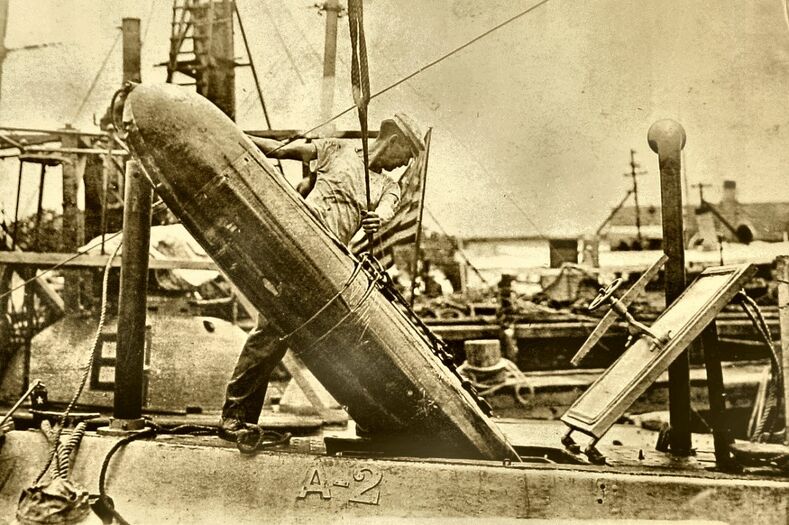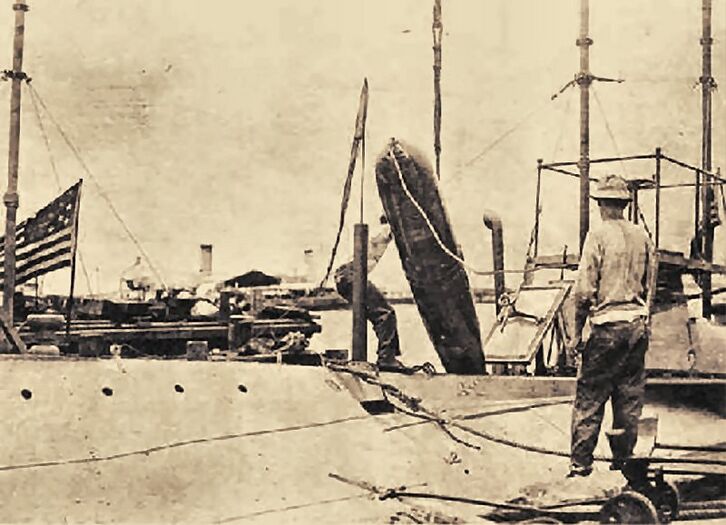Torpedo photos & information
Whitehead Mk 2 & Mk 3
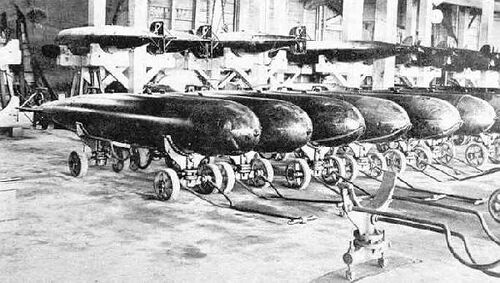
Whitehead Mk 3 torpedoes stored at the weapons depot at Naval Station Cavite, Philippines, approximately 1906. The wheeled carts allowed the quick movement of the weapons from storage to the pier.
Photo in the private collection of Ric Hedman.
-
Photo NH 90188 courtesy of the NHHC.
-
U.S. Navy photo.
Navy photos of a Mk 3 weapon being loaded into the USS A-2 (Submarine No. 3) at Naval Station Cavite, Philippines, circa 1912. The sailor manhandling the weapon down the hatch gives a good sense of scale to the torpedo, and illustrates how short the mid-body was compared to later torpedoes. Our early submarines were restricted to the use of these short weapons because they were the only ones that would fit inside the boats and the tubes they used. That would quickly change.
Bliss-Leavitt Mk 4 Mod 1
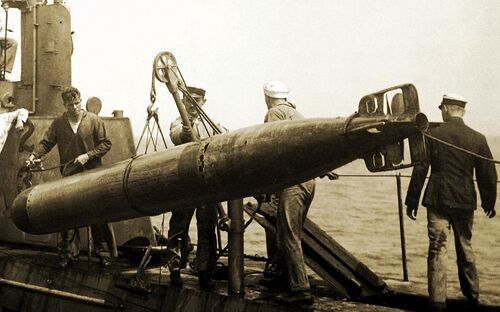
D-3 hoisting aboard a Mk 4 torpedo that it as just recovered from a practice shot, circa 1912. This photo gives a good view of the aft end of the weapon, including the control surfaces and the twin contra-rotating propellers. The twin propellers spinning in opposite directions eliminated roll torque, preventing the weapon from cork-screwing along its longitudinal axis. Eliminating the roll torque also allowed the gyro to maintain a more accurate course. Note the two very small rudders mounted in cutouts in the upper and lower skeg. The depth control planes were larger but mounted in a similar fashion. The rudder and planes skegs continue aft and form a + shaped guard around the propellers that is attached to the very aft end of the weapon. This was done out of concern that the torpedo's aft end may strike the edge of the tube while exiting and damage the control surfaces and the props.
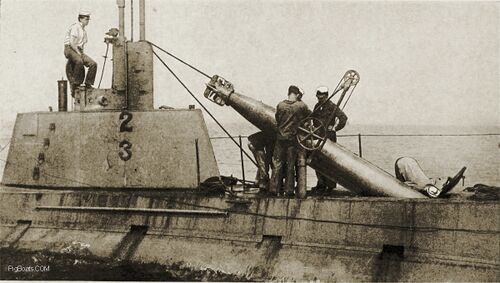
Another view of the operation shown above. There is a snubbing line attached to the aft end of the weapon, looped around the #1 periscope. This line allowed the weapon to be gently and carefully lowered into the torpedo room.
Bliss-Leavitt Mk 6
Currently, PigBoats.COM does not have a good picture of a Mk 6. An idea for its appearance can be gained from the Mk 7 pictures below.
Bliss-Leavitt Mk 7
In 1922 the Navy undertook a purge of older torpedoes in an effort to simplify the supply chain and ease training issues. All torpedoes prior to the Mk 7 were recalled and removed from service. As we moved towards WWII the Mk 7 was showing its age, but it was retained so that the Navy could equip the old O-class boats that were being brought out of reserve to train new submarine crews. It was the last 18" torpedo used by the Navy.
Bliss produced four additional versions of the Mk 7 for use as aircraft dropped torpedoes. These were pulled out of service when the new Mk 13 was introduced in 1938.
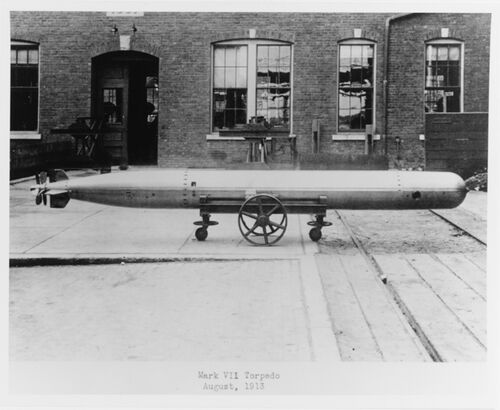
A Mk 7 torpedo on a cart at NTS Newport, August 1913. Overall, it was virtually identical to the Mk 6 in appearance, but it was equipped the the more powerful wet-heater engine. Note the control surfaces forward of the twin contra-rotating propellers. It was a good weapon, but was considered to have an underpowered warhead at only 205 lbs of TNT.
Photo courtesy of the NHHC.
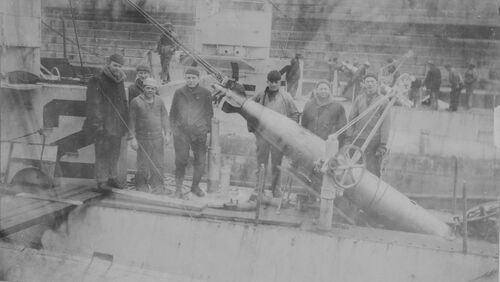
Mk 7's being loaded onto the L-2 (Submarine No. 41) and L-4 (Submarine No. 43) while in drydock in Bantry Bay Ireland, 1918. The weapon in on the skid and a snubbing line is noosed around the tail. The snubbing line is wrapped around #1 periscope, using the scope as a block to assist lowering the weapon into the torpedo room. The crewman in the peacoat and watch cap right at the aft end of the torpedo is standing on the retracted 3"/23 caliber Mk 9 deck gun.
Photo courtesy of NARA and Navsource.
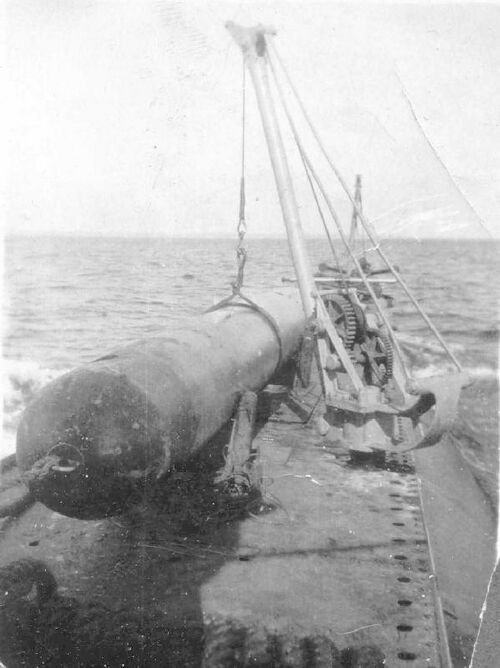
K-5 (Submarine No. 36) with a retrieved Mk 7 exercise shot on deck, early 1920's. The explosive warhead has been removed and a water filled inert warhead has replaced it. Torpedoes were very expensive, so there was a great deal of emphasis on retrieving them and reusing them after a peacetime training exercise. At the end of the run, the remaining air in the weapon's air flask would be used to blow the water out of the practice warhead, allowing the weapon to float so that it could be retrieved by the boat that fired it. It only took a half-hour or so to replace the practice head with the real thing if needed.
Photo in the private collection of Ric Hedman.
Bliss-Leavitt Mk 9 Mod 1B
Shortly after its introduction, the Navy made the tactical decision to discontinue torpedo use on battleships, moving that mission to cruisers and destroyers. The short Mk 9 was ideally suited for submarine use and thus it was modified (Mod 1B) for that new platform. The submarines of the R-class and S-class were in part designed around these weapons and the follow-on Mk 10.
The numbers built were relatively low, as it was supplanted by the Mk 10 with its bigger warhead. The Mk 9 proved to be the swan-song of the E.W. Bliss Company. When production ceased on it in 1920 the Navy awarded no further contracts to Bliss, preferring to consolidate all torpedo production at NTS Newport. The Mk 9, however, was a good weapon and it stayed in the Navy's inventory as a means to supplement the Mk 10. Mk 9's were known to be in the Philippines at the start of World War II in 1941, and some made it to the resupply inventory at Dutch Harbor in the Aleutians, and they were used in combat by the S-boats in those theaters. As far as can be determined, the Mk 9 Mod 1B stayed in Navy use until the end of the war to equip R and S-class submarines stateside, but it is doubtful that they were used in combat in the western Pacific theater much past mid 1942. Once production numbers caught up the Mk 10 was preferred due to its much more powerful warhead.
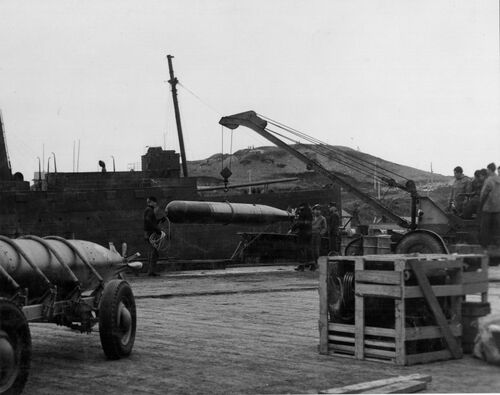
A Mk 9 Mod 1B torpedo being swung over to the USS S-34 (SS-139) at Naval Operating Base Dutch Harbor, AK, May 14, 1942. The blunt nose of this weapon is apparent here. Another reload is waiting on a cart to the left. A poorly managed industrial base stateside lead to torpedo shortages early in the war and thus the Mk 9's were thrown into action to supplement the Mk 10's until production caught up.
NARA Photo # 80-G-14096 via Navsource.
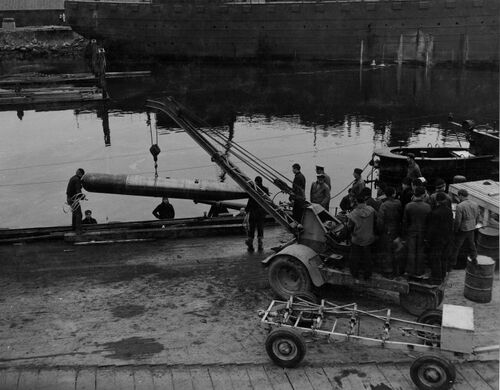
Another view of the scene above. Two lines of bolts run the circumference of the weapon, dividing it into three sections. On the left is the warhead and exploder, the middle contains the high pressure air flask and alcohol tank, and on the right is the engine, control surfaces, and propellers. For practice firings, the warhead could be replaced with an exercise head that contained an inert calcium chlorite mixture that simulated the weight of the warhead. Changing the nose was relatively easy and would take less than an hour.
NARA Photo # 80-G-14098 via Navsource.
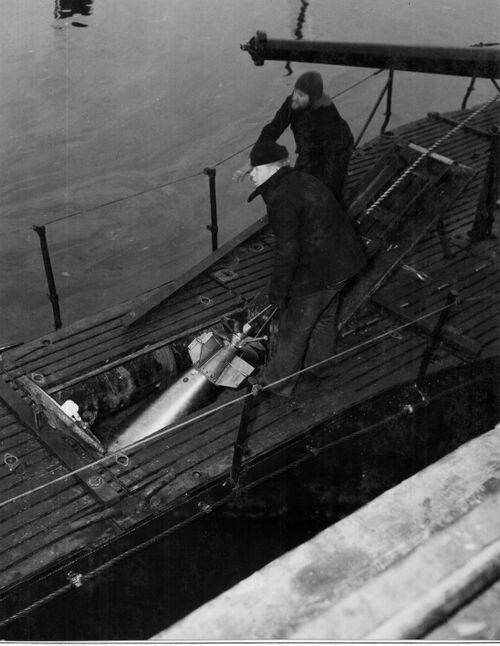
A Mk 9 torpedo being gingerly lowered into the torpedo room of S-34 while at Dutch Harbor, AK, May 14, 1942. The weapon is being lowered down the inclined loading skid through the loading hatch. A snubbing line attached to the aft end controls the rate of descent. This photo gives a good view of the aft end of the torpedo, with the rudder and depth control planes visible, along with the twin contra-rotating propellers. The vertical rudders are actually quite small, as they were used once to turn the weapon onto its preprogrammed course, then to make minor adjustments to keep the weapon on course based on inputs from the very accurate gyroscope, essentially running straight to the impact point.
However, The pressure sensors used to keep the torpedo on the set depth were still a developing technology and were far less precise than gyroscopes. Because of that the torpedo needed more control authority to keep depth. In actuality, most torpedoes of this era tended to run towards their target in an up and down "sine-wave", deviating above and below its set depth by as much as 2-4 feet. This dictated the much larger depth control planes to help dampen this sine-wave out.
NARA Photo # 80-G-14097 via Navsource.
Bliss-Leavitt/BuOrd Mk 10 Mod 3
The initial Mod 0 version of the weapon was quite similar to the Mk 9, although it had a slightly more tapered shape to the warhead section. It had a shorter range than the Mk 9, but was slightly faster. Still not satisfied with the size of the warhead, NTS personnel tinkered with the design, eventually settling on the Mod 3 version with its warhead of 497 lbs of TNT, the most powerful torpedo warhead for the USN up to that time. The speed was also increased to 36 knots, but at the sacrifice of range, which fell to 3500 yards.
A stunted testing program in the 1920's and 30's failed to reveal a depth keeping problem with this weapon. Testing in 1942 showed that it tended to run four feet deeper than set, leading to a large number of misses during the first six months of the war. For some inexplicable reason, the fact that the water filled exercise warhead weighed less than the TNT warhead had been missed, and the depth setting mechanism was calibrated based on the data received from a few test runs using the exercise head. No actual end-to-end runs with a detonation of the explosive head were ever run. Thus, once the war started and the S-boats started firing warshots they were missing at an alarming rate. Only the tendency of the weapon to run in a shallow up and down sine-wave through the water resulted in detonation hits. Once this problem was discovered it was a simple fix to correct the issue, and the Mk 10 overall turned in excellent service during the war. The S-44 (SS-155) got three Mk 10 hits on the heavy cruiser HIJMS Kako in 1942. The cruiser sank in minutes.
The introduction of Torpex explosive (40% TNT, 18% powdered aluminum, 42% RDX) in 1942 gave the Mk 10 and other torpedoes "one hell of a wallop". The increased power of Torpex actually enabled a reduction in the weight of the warhead to 485 lbs.
In the early months of WWII, one of the problems facing the Submarine Service was a lack of torpedoes. For various reasons (none good) the Mk 14 torpedoes used by the fleet submarines were in short supply. On several occasions fleet boats went out of patrol carrying Mk 10 torpedoes to supplement the short-stocked Mk 14's.
Use of the Mk 10 in combat wound down in 1944 as the S-boats were pulled from active war patrols and sent back stateside to perform less dangerous but still vital training missions. The weapon continued to serve the U.S. Navy well until the end of the war.
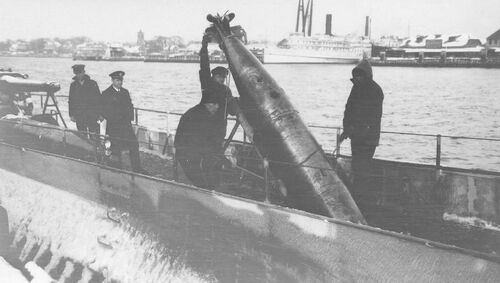
A Mk 10 slowly sliding down the loading skid of the USS S-48 (SS-159), December 1928. Instead of a snubbing line attached to the aft end of the weapon, a line and pulley system is attached to the nose of the torpedo, with a man on each side of the skid controlling its descent.
Photo in the private collection of Ric Hedman.
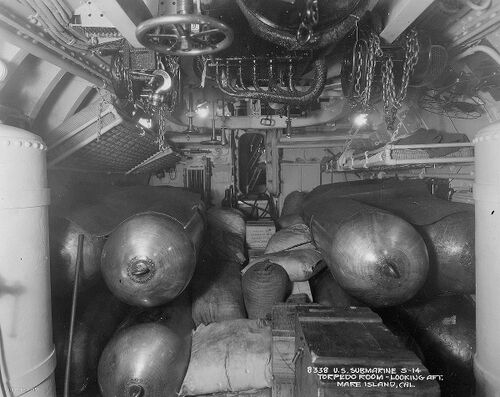
The eight Mk 10 reloads for the S-14 (SS-119) are shown stowed in her torpedo room in January 1928. The padeye on the nose of the weapon indicates that these are all exercise heads. Stores for a long trip from Mare Island down to Coco Solo, Panama are stashed in and amongst the weapons.
USN photo #8338 via NHHC.
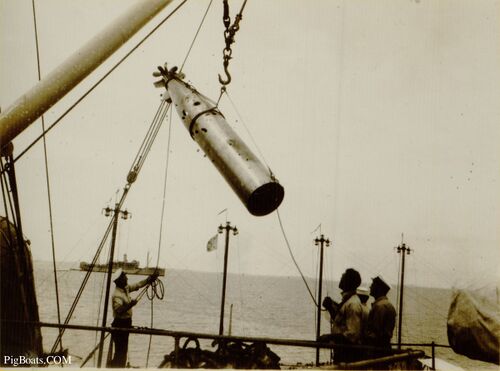
A Mk 10 minus its warhead is being hoisted aboard the S-31 (SS-136) from the tender Beaver (AS-5), approximately 1927. Once the weapon was aboard, it would take the crew only about an hour to attached either a warhead or an exercise head.
Photo in the private collection of Ric Hedman.
BuOrd Mk 14
The submarine version would be designated the Mk 14. At 20' 6" long it was far too long to be used by the S-boats, but perfectly sized for the new fleet submarines then being built. The longer length gave it a much longer range and a advanced wet-heater steam turbine engine gave a stunning speed of up to 46 knots. It also had a brand new feature: a dual speed setting. If set to the lower speed setting of 31 knots it had a range of 9000 yards. At the higher speed the range was 4500 yards.
One of the features of the Mk 14 was the brand new and top-secret Mk 6 exploder mechanism. This exploder was designed to sense the magnetic field of the target and detonate the warhead as the torpedo passed directly under the keel. Ships did not carry armor in this location and the concept of incompressibility of water meant that these types of detonations would have a devastating effect.
The Mk 14 was produced solely at NTS Newport. It was a very intricate and finely crafted piece of machinery, literally hand crafted one-by-one. In theory it gave the operating forces a tremendous tactical advantage and the staff of Newport and the Bureau of Ordnance were justifiably proud of the "wonder weapon" that they had produced.
However, this weapon came along as the nation was wallowing in the depths of the Great Depression. Thus the testing program was very stunted and unrealistic. Put into full production without being adequately tested the torpedo had numerous faults; they were of such a nature as to be difficult to find if not rigorously tested. Once the war started, alarming reports of torpedo malfunctions began to surface as misses began to rack up. The problems could be grouped into three major areas: deep running, erratic course keeping, and the complete failure of the Mk 6 exploder in either influence or contact mode. The leaders of the BuOrd and the technicians at NTS Newport steadfastly refused to believe anything was wrong with the weapon that they had developed. They blamed all of the faults on the operating forces and refused to do anything about it. Only when high level officers ordered field tests and put personal pressure on the Newport staff did they finally admit that there were problems. It took until the summer of 1943 before the issues with the Mk 14 were corrected. The tarnish of The Great Torpedo Scandal was finally put aside and the Mk 14 turned in fine performance afterwards, becoming responsible for several million tons of enemy shipping.
As it turned out, the low speed setting was rarely used. The higher speed of 46 knots turned out to be more valuable to the submarine crews than the longer range. The Mk 14 was eventually refitted with a Torpex warhead of up to 643 lbs. This gave it a potent punch. The influence feature of the Mk 6 exploder was permanently deactivated and thereafter used as a simple contact exploder.
Westinghouse Mk 18 Mod 1
BuOrd Mk 23
Page created by:
Ric Hedman & David Johnston
1999 - 2023 - PigBoats.COM©
Mountlake Terrace, WA, Norfolk, VA
webmaster@pigboats.com

